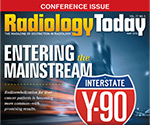 |
In addition to blocking blood flow, ischemic strokes cause harmful enzymes to become active in the brain areas where blood flow is cut off. If not treated promptly, these enzymes can cause brain damage. A new, noninvasive technique developed by researchers at the University of Missouri School of Medicine and the University of California, San Diego, allows doctors to see these molecular changes in real time. The technique involves tagging peptides with MRI contrast agents so that the peptides light up the brain areas that are affected by enzyme activity. The researchers hope that this real-time view of poststroke brain activity will lead to better stroke treatments. Read all about it in this E-News Exclusive.
— Dave Yeager, editor |
 |
 |
New Imaging Technique May Give Physicians Clearer Picture
of Stroke Damage
According to the American Heart Association, ischemic strokes account for nearly 90% of all strokes. They occur when a blocked artery prevents blood from getting to the brain and usually result in long-term disability or death. Now, a team of researchers led by the University of Missouri (MU) School of Medicine has developed a new, real-time method of imaging molecular events after strokes―a finding that may lead to improved care for patients.
“During an ischemic stroke, harmful enzymes called gelatinase become overactive in areas of the brain where blood flow is cut off,” says Zezong Gu, PhD, an associate professor of pathology and anatomical sciences at the MU School of Medicine and lead author of the study. “Overactivation of these enzymes causes brain damage. Our team hypothesized that if we could visualize and track this activity in real time, we could then work on developing a way to block the activity and prevent brain damage from occurring.”
Full story » |
 |
 |
Paging HAL
As the uses and abilities of artificial intelligence continue to improve and advance, radiologists have begun to speculate on how the technology may affect their industry in the near future. Read more »
Aiming Higher
New standards announced by The Joint Commission earlier this year have placed a greater emphasis on the safety of CT patients and on those technologists that perform the scans. Read more »
Entering the Mainstream
While it has been an option for more than a decade, using radioembolization to treat two types of liver cancer has become more common in recent years. Read more »
Front- vs Back-End Speech Recognition: Which Fits Better?
Health care organizations must take into account several factors before making the leap. Read more » |
 |
|
|
 |
“The strength of your radiology practice depends on the strength of your leadership.”
— Cheri Canon, MD, FACR, chair of the program committee for the ACR’s annual meeting, scheduled to take place in Washington, D.C. later this month |
 |
|
